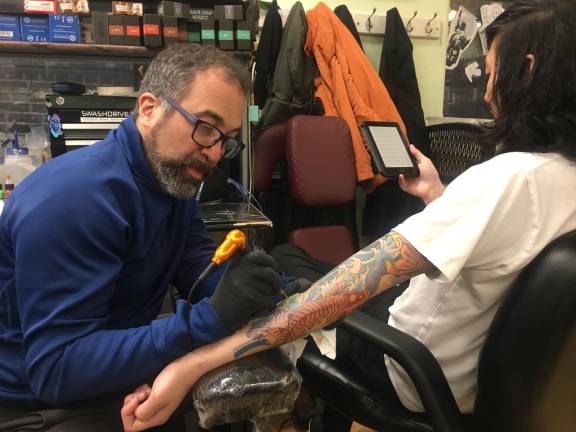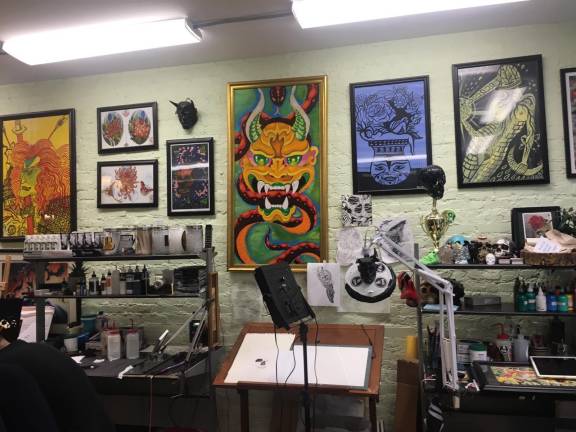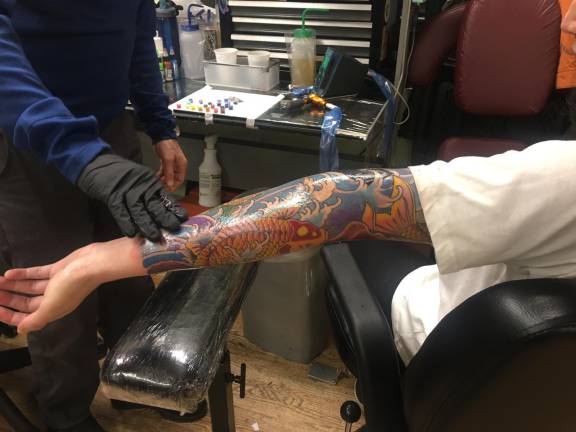Rising Dragon, a tattoo parlor on West 14th Street, is already open when owner Darren Rosa walks in at 2 p.m. on a recent Sunday. He only has one client today, so he drove his white Toyota from his home in Yonkers without rushing.
Three of the five tattoo artists who work in Rosa’s second floor shop have already arrived and are inking clients while McShan’s rap resonates through the floor. Rosa gets rid of his Gore-Tex orange cap and takes up position by his desk in the right corner of the room.
He was 19 when he did his first tattoo in his bedroom in Washington Heights. He remembers it well: a small parachute for a client who said he was in the Air Force. “He might have been lying, who knows? He was a young punk,” Rosa recalled, laughing, in a conversation a few days earlier.
Now, 35 years later, he draws colorful samurais, red and green dragons and black tigers, reflecting the Japanese artwork he enjoys. Paintings of yellow snakes and orange demons decorate the shop walls.
His client, Jay Kwak, arrives a couple of minutes later. A skinny 25-year old software developer with long black hair, he found Rosa by googling Japanese tattoos last year. He instantly fell in love with his style and got his first tattoo last June.
“Let’s get started, Jay,” says Rosa, pulling on a pair of latex black gloves.
Kwak takes a Kindle out of his backpack, settles into a comfortable armchair and extends his left arm, already partly covered by the bright koi Rosa created last year. For the next five hours, Kwak patiently reads “The Count of Monte Cristo,” while his forearm bleeds at each touch of the needle. In total, the whole arm tattoo will cost him $1,500.
Kwak wants the same tattoo continuing down the rest of his arm - orange, red and yellow koi swimming through blue water amid gray rocks. That’s become Rosa’s favorite kind of work, though when he started out, he mostly tattooed in black. “New Yorkers in general like black work. Maybe it’s all the great buildings, maybe they are surrounded by too much stimulation and want something simple,” he muses.
"I was an introvert"
Rosa, 54, grew up in a rough neighborhood in Upper Manhattan when tattooing was illegal in New York City. After a hepatitis B outbreak in 1961, the city prohibited tattooing until 1997.
Rosa’s mom discouraged her children from spending time in the streets, afraid of the gangs that proliferated in the 70s. His dad wasn’t around and his two sisters spent their time together. So Rosa started drawing. “I was an introvert,” he says.
His mother, Anna Maria Melo, a retired school teacher, remembers a shy kid drawing in his bedroom. “He got a job doing what he liked and he was good at it,” she says proudly.
By 1984, Rosa had already chiseled three tattoos on his body and was trying his hand with the needle. The first: a snake and a skull saying “death before chains” on his right bicep. “I was reading a lot of Nietzsche,” he explains. “He was talking about false institutions made to chain us.”
Today he has between 50 and 60 tattoos (he can’t remember the precise number), including an enormous black hawk covering his chest and his initials on his index finger knuckles.
Now, when he talks about politics (he believes elections are rigged), religion (he’s Catholic but doesn’t practice) or family (married, three kids), Rosa hardly sounds like an introvert. But he looks constantly distracted.
After an hour and a half working on Kwak’s arm, Rosa leaves his needle and orders hummus and pita via GrubHub. The food arrives thirty minutes later, so he leaves Kwak’s arm and sinks into the couch opposite his desk.
His employee Chris, who declined to give his last name, hasn’t had a client for the past 40 minutes, so he sits next to the boss, listening to music on his smartphone.
Lunch takes 15 minutes. Rosa, done with the fish, turns to the small turtle he outlined two weeks earlier on Kwak’s arm.
Grad school for research psychology
Rosa started tattooing while he studied psychology at City College. But with people coming in and out of his apartment for $20 tattoos, “my business was fucking with my mom’s life,” he admits. At 23, he moved out into a co-op apartment. “The building manager threatened me,” he recalls. “He thought I was selling drugs.”
Rosa went to grad school for research psychology but when his tattooing demanded too much time, he dropped out. “My grandfather was not happy; he kept telling me about the psychologists he knew who made millions of dollars,” he says.
Rosa thrived in the late 80s, hiring other tattooists to work at his apartment. However, with new shops downtown, clients tired of trekking uptown on the subway for an hour to Washington Heights. So in 1992, Rosa moved his shop to 19th Street and Fifth Avenue; and in 2008, to this 14th Street location. Business is good, he says, declining to be more specific about profits.
Rosa goes back to Kwak’s arm while his client stares at his Kindle. The bright green turtle is finished; only the water and the rocks remain to be inked.
It’s 6: 30 p.m. when Kwak, still stoic, examines his colored skin. “It’s beautiful,” says Rosa.
Rosa applies a soothing ointment and wraps Kwak’s arm with bandages and plastic film. Kwak stashes his Kindle in his backpack, pays Rosa in cash, and leaves.
Rosa discards his latex gloves and puts on his jacket and orange cap which reads “The Dude” on the back. “I don’t want anyone taking it by mistake,” laughs Rosa.
It’s 7 p.m.; the shop will be open for two more hours. By then, Rosa will be home in Yonkers with his children, his sketches and his backyard. Outside he points at his car’s license plate: “RSNGDRG,” the name of his shop.
“Cool, huh?” He drives off, leaving Manhattan behind.


